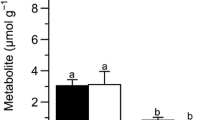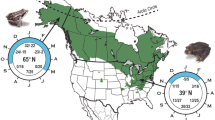Abstract
Freeze tolerance is a complex cold-hardiness adaptation that has independently evolved in a diverse group of organisms, including several ectothermic vertebrates. Because little is known about the mechanistic basis for freeze tolerance in reptiles, we compared responses to experimental freezing in winter-acclimatized hatchlings representing nine taxa of temperate North American turtles, including ones that tolerated freezing and others that did not. Viability rates of hatchlings frozen to −3°C for 72 h ranged from 0 to 100%. Tolerance to freezing was poor in Sternotherus odoratus, Graptemys geographica and Trachemys scripta, intermediate in Chelydra serpentina, and high in Emydoidea blandingii, Chrysemys picta bellii, C. p. marginata, Malaclemys terrapin, and Terrapene ornata, and generally reflected the winter thermal ecology of each taxon. Plasma activity of lactate dehydrogenase (LDH), a novel in vivo index of freeze/thaw damage, corroborated viability assessments and demonstrated that cryoinjury occurred even in surviving turtles. Irrespective of taxon, cryoinjury tended to be higher in smaller individuals and in those having relatively low water contents; however, bases for these associations were not apparent. Screening for certain organic osmolytes that might promote freezing survival by colligatively reducing ice content and limiting cell dehydration showed that the plasma of unfrozen (control) turtles contained small quantities of glucose (1.3–5.8 mmol l−1) and lactate (0.6–3.2 mmol l−1) and modest amounts of urea (range of mean values for all taxa 8.2–52.3 mmol l−1). Frozen/thawed turtles of all taxa accumulated modest amounts of glucose and lactate that jointly raised the plasma solute concentration by 30–100 mmol l−1. We conclude that organic osmolytes accumulated both before and during freezing may promote survival in species that have evolved a tolerance to freezing, but are not necessarily accumulated for that purpose.


Similar content being viewed by others
References
Addo-Bediako A, Chown SL, Gaston KJ (2000) Thermal tolerance, climatic variability and latitude. Proc R Soc Lond 267:739–745
Attaway MB, Packard GC, Packard MJ (1998) Hatchling painted turtles (Chrysemys picta) survive only brief freezing of their bodily fluids. Comp Biochem Physiol A 120:405–408
Baker PJ, Costanzo JP, Herlands R, Wood RC, Lee RE (2006) Inoculative freezing promotes winter survival in hatchling diamondback terrapin, Malaclemys terrapin. Can J Zool 84:116–124
Baker PJ, Costanzo JP, Iverson JB, Lee RE (2003) Adaptations to terrestrial overwintering of hatchling northern map turtles, Graptemys geographica. J Comp Physiol B 173:643–651
Bleakney S (1963) Notes on the distribution and life histories of turtles in Nova Scotia. Can Field Nat 77:67–76
Burke RL, Hussain AA, Storey JM, Storey KB (2002) Freeze tolerance and supercooling ability in the Italian wall lizard, Podarcis sicula, introduced to Long Island, New York. Copeia 2002:836–842
Cagle FR (1944) Activity and winter changes of hatchling Pseudemys. Copeia 1944:105–109
Cameron AT (1930) Temperature and life and death. Trans R Soc Can 1930:53–92
Churchill TA, Storey KB (1991) Metabolic responses to freezing by organs of hatchling painted turtles Chrysemys picta marginata and C. p. bellii. Can J Zool 69:2978–2984
Churchill TA, Storey KB (1992) Natural freezing survival by painted turtles Chrysemys picta marginata and C. picta bellii. Am J Physiol 262:R530–R537
Claussen DL, Costanzo JP (1990) A simple model for estimating the ice content of freezing ectotherms. J Therm Biol 15:223–231
Costanzo J, Grenot C, Lee RE (1995a) Supercooling, ice inoculation, and freeze tolerance in the European common lizard, Lacerta vivipara. J Comp Physiol B 165:238–244
Costanzo JP, Dinkelacker SA, Iverson JB, Lee RE (2004) Physiological ecology of overwintering in the hatchling painted turtle: multiple-scale variation in response to environmental stress. Physiol Biochem Zool 77:74–99
Costanzo JP, Iverson JB, Wright MF, Lee RE (1995b) Cold hardiness and overwintering strategies of hatchlings in an assemblage of northern turtles. Ecology 76:1772–1785
Costanzo JP, Lee RE (1995) Supercooling and ice nucleation in vertebrates. In: Lee RE Jr, Warren GJ, Gusta LV (eds) Biological ice nucleation and its applications. American Phytopathological Society Press, St Paul, pp 221–237
Costanzo JP, Lee RE (2005) Cryoprotection by urea in a terrestrially-hibernating frog. J Exp Biol 208:4079–4089
Costanzo JP, Litzgus JD, Iverson JB, Lee RE (2000) Seasonal changes in physiology and development of cold hardiness in the hatchling painted turtle, Chrysemys picta. J Exp Biol 203:3459–3470
Dinkelacker SA, Costanzo JP, Iverson JB, Lee RE (2003) Cold hardiness and dehydration resistance of hatchling Blanding’s turtles (Emydoidea blandingii): implications for overwintering in a terrestrial habitat. Can J Zool 82:594–600
Dinkelacker SA, Costanzo JP, Lee RE (2005) Anoxia tolerance and freeze tolerance in hatchling turtles. J Comp Physiol B 175:209–217
Ewert MA, Legler JM (1978) Hormonal induction of oviposition in turtles. Herpetologica 34:314–318
Hemmings SJ, Storey KB (2000) Hepatic changes in the freeze-tolerant turtle Chrysemys picta marginata in response to freezing and thawing. Cell Biochem Funct 18:175–186
Layne JR Jr, Jones AL (2001) Freeze tolerance in the gray treefrog: cryoprotectant mobilization and organ dehydration. J Exp Zool 290:1–5
Lee RE (1991) Principles of insect low temperature tolerance. In: Lee RE, Denlinger DL (eds) Insects at low temperature. Chapman and Hall, New York, pp. 17–46
Lee RE, Costanzo JP (1998) Biological ice nucleation and ice distribution in cold-hardy ectothermic animals. Annu Rev Physiol 60:55–72
Loomis SH, Carpenter JF, Anchordoguy TJ, Crowe JH, Branchini BR (1989) Cryoprotective capacity of end-products of anaerobic metabolism. J Exp Zool 252:9–15
Mazur P (2004) Principles of cryobiology. In: Fuller BJ, Lane N, Benson EE (eds) Life in the frozen state. CRC, Washington, pp 3–65
Nagle RD, Burke VJ, Congdon JD (1998) Egg components and hatchling lipid reserves: parental investment in kinosternid turtles from the southeastern United States. Comp Biochem Physiol B 120:145–152
Obbard ME, Brooks RJ (1981) Fate of overwintered clutches of the common snapping turtle (Chelydra serpentina) in Algonquin Park, Ontario. Can Field Nat 95:350–352
Packard GC, Packard MJ (1993) Delayed inoculative freezing is fatal to hatchling painted turtles (Chrysemys picta). CryoLett 14:273–284
Packard GC, Packard MJ (2003) Cold acclimation enhances cutaneous resistance to inoculative freezing in hatchling painted turtles, Chrysemys picta. Funct Ecol 17:94–100
Packard GC, Packard MJ, Lang JW, Tucker JK (1999) Tolerance for freezing in hatchling turtles. J Herpetol 33:536–543
Packard MJ, Packard GC (2004) Accumulation of lactate by frozen painted turtles (Chrysemys picta) and its relationship to freeze tolerance. Physiol Biochem Zool 77:433–439
Pörtner HO (2002) Climate variations and the physiological basis of temperature dependent biogeography: systemic to molecular hierarchy of thermal tolerance in animals. Comp Biochem Physiol A 132:739–761
Reese SA, Ultsch GR, Jackson DC (2004) Lactate accumulation, glycogen depletion, and shell composition of hatching turtles under simulated aquatic hibernation. J Exp Biol 207:2889–2895
Rowe JW, Holy L, Ballinger RE, Stanley-Samuelson D (1995) Lipid provisioning of turtle eggs and hatchlings: total lipid, phosphoplipid, triacylglycerol and triacyl glycerol fatty acids. Comp Biochem Physiol B 112:323–330
Sinclair BJ, Marshall DJ, Singh S, Chown SL (2004) Cold tolerance of Littorinidae from southern Africa: intertidal snails are not constrained to freeze tolerance. J Comp Physiol B 174:617–624
Sinclair BJ, Roberts SP (2005) Acclimation, shock, and hardening in the cold. J Therm Biol 30:557–562
Storey KB (2006) Reptile freeze tolerance: metabolism and gene expression. Cryobiology 52(1):1–16
Storey KB, Mommsen TP (1994) Effects of temperature and freezing on hepatocytes isolated from a freeze-tolerant frog. Am J Physiol 266:R1477–R1482
Storey KB, Storey JM (1988) Freeze tolerance in animals. Physiol Rev 68:27–84
Storey KB, Storey JM, Brooks SPJ, Churchill TA, Brooks RJ (1988) Hatchling turtles survive freezing during winter hibernation. Proc Natl Acad Sci USA 85:8350–8354
Yancey PH (2005) Organic osmolytes as compatible, metabolic and counteracting cytoprotectants in high osmolarity and other stresses. J Exp Biol 208:2819–2830
Acknowledgments
We thank P. Myer and the Connealy and Davis families for granting us permission to collect turtles on their lands. We also thank S. Dinkelacker for providing some of the hatchlings, and M. Elnitsky and T. Muir for commenting on the manuscript. Collecting permits were obtained from the Nebraska Game and Parks Commission, Indiana Department of Natural Resources, and New Jersey Division of Fish and Wildlife. Experimental procedures were approved by the Animal Care and Use Committee of Miami University. This work was funded by grants from the National Science Foundation (IBN 98017087 and IOB 0416750) to JPC and by the Miami University Summer Workshop (PJB).
Author information
Authors and Affiliations
Corresponding author
Additional information
Communicated by H.V. Carey
Rights and permissions
About this article
Cite this article
Costanzo, J.P., Baker, P.J. & Lee, R.E. Physiological responses to freezing in hatchlings of freeze-tolerant and -intolerant turtles. J Comp Physiol B 176, 697–707 (2006). https://doi.org/10.1007/s00360-006-0092-9
Received:
Revised:
Accepted:
Published:
Issue Date:
DOI: https://doi.org/10.1007/s00360-006-0092-9




